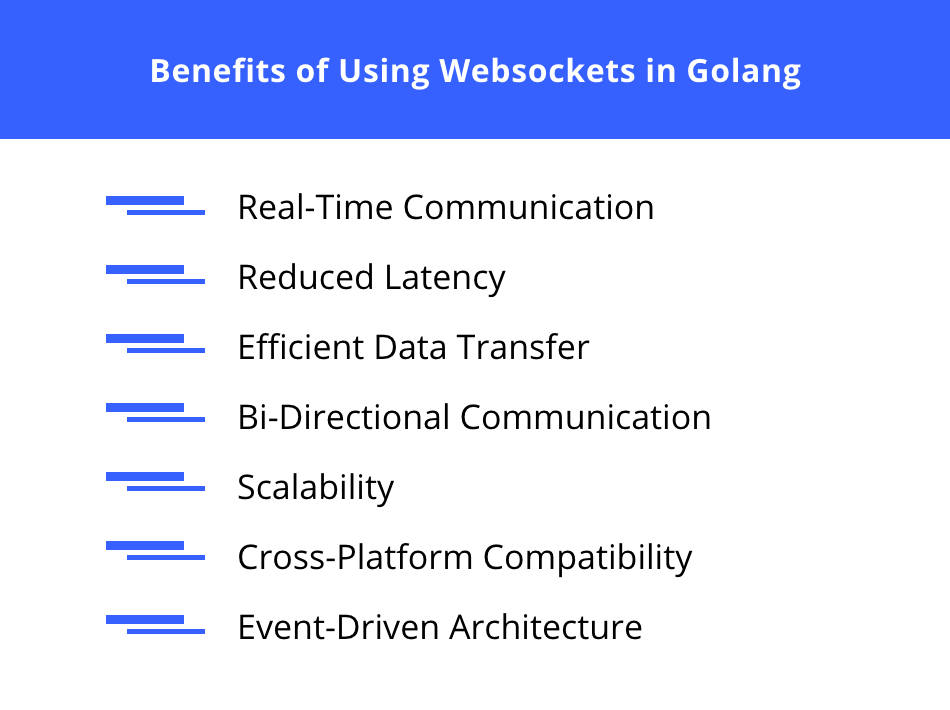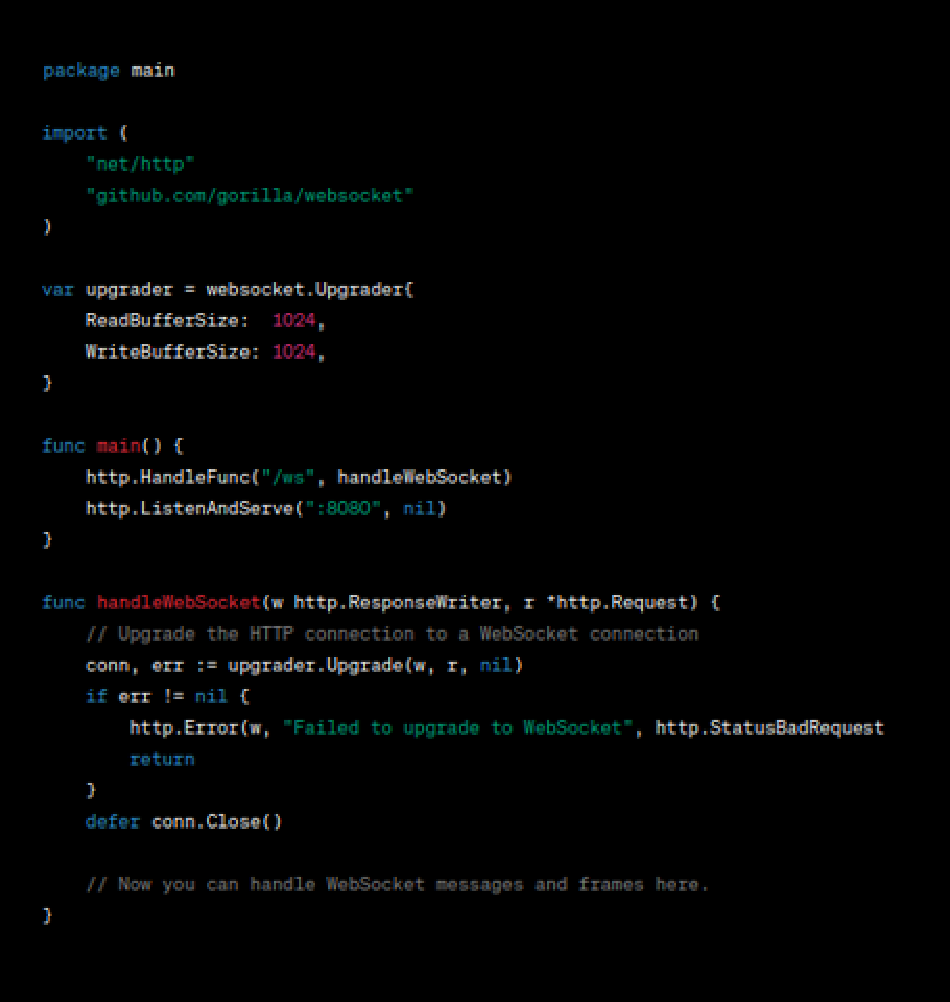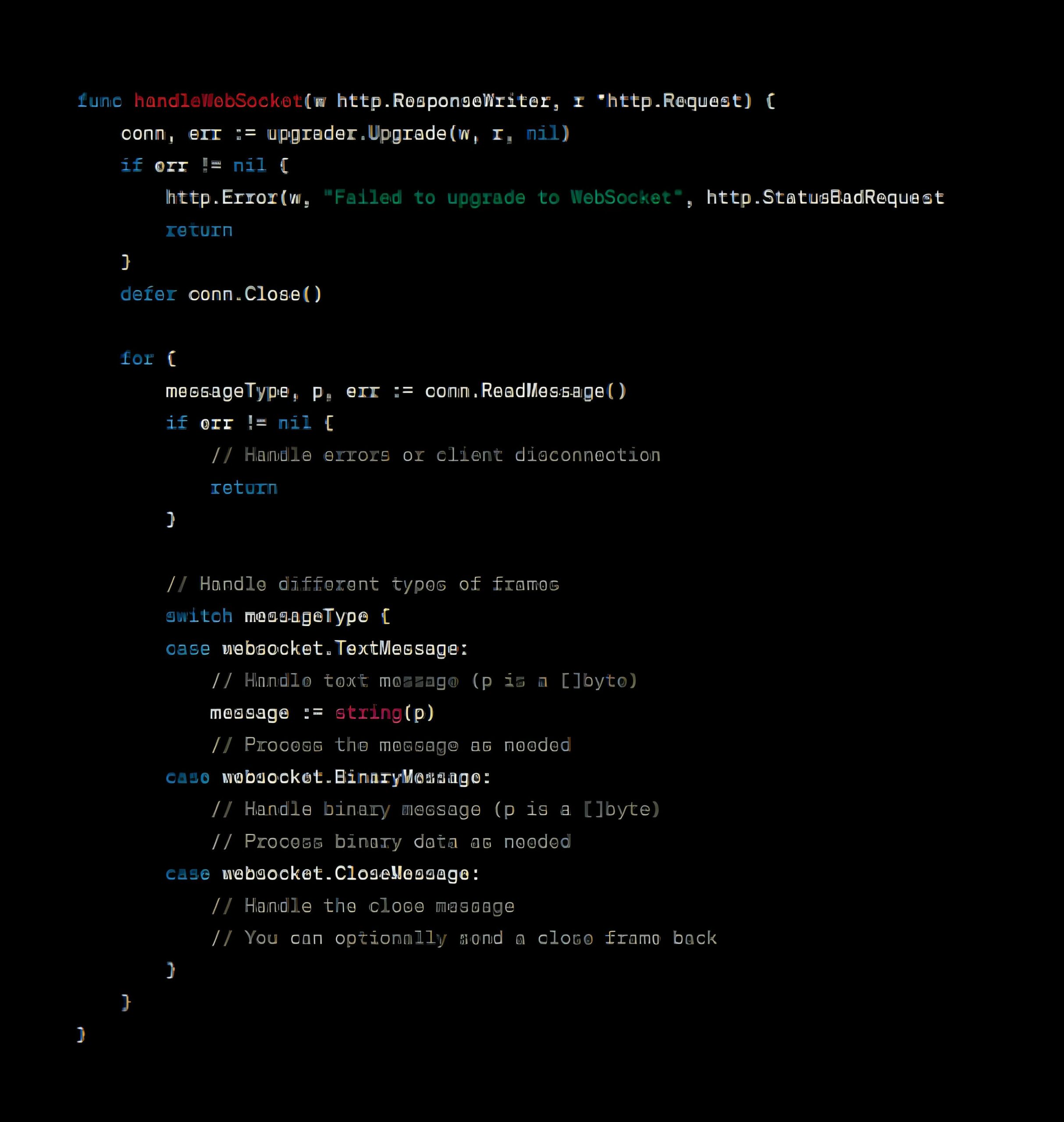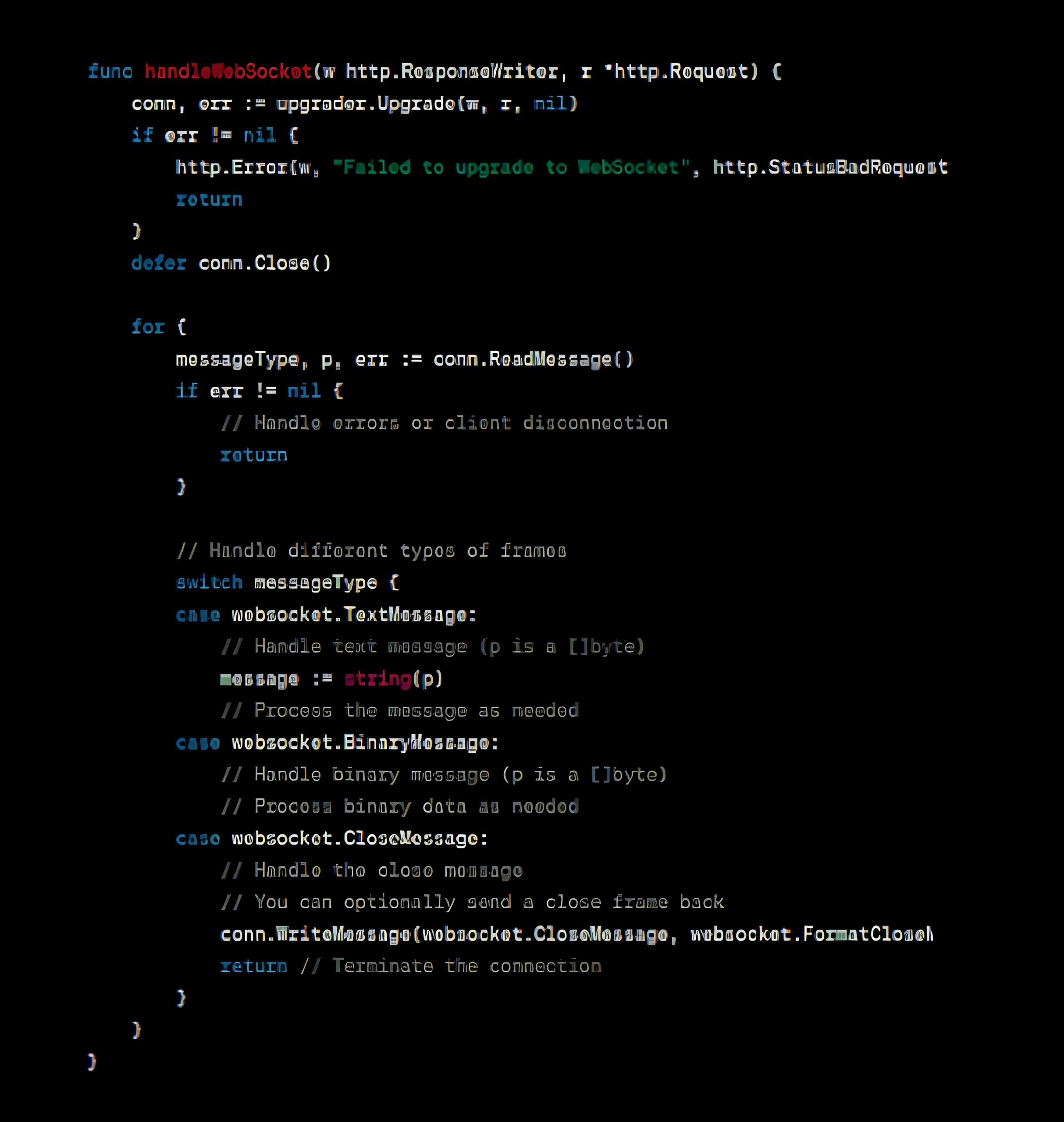Explore the power of bi-directional communication by leveraging the most popular websockets in Golang, making your app development journey smooth and effortless.
Updated 16 February 2024

CEO at Appventurez
In the swiftly evolving realm of software development, propelled by advanced technologies and innovative app-building methodologies, developers are in constant search of optimal tools and approaches to construct resilient and high-performing applications. Amidst this digital revolution, Golang, a high-level programming language developed by Google, has emerged as a preferred choice for developers. Leveraging the capabilities of real-time communication and integrating websockets in Golang, developers find themselves equipped to create top-tier business app solutions.
However, navigating the intricacies of setting up the development environment and building apps with Golang websockets can be a challenging endeavor. Fortunately, enlisting the services of a professional Golang development company can provide invaluable assistance. Their expertise allows you to navigate the complexities of app development seamlessly, particularly when working with Golang websocket servers. If you’re considering venturing into the realm of Golang development, hire Golang developers is a prudent step towards ensuring a smooth and successful development process.
A Websocket in Golang is a communication protocol that enables two-way, real-time communication between client and server. Simply put, Go websockets enable browsers to share and receive messages from the client to the server without polling the latter to respond
Getting instant responses from the server side without refreshing the entire page has become the new normal. However, in the past, it used to be a challenge to enable real-time functionality in web apps. The developer community had to find a solution that could replace the conventional HTTP long polling method and build truly high-performing real-time applications.
The solution came in the form of websockets in Golang, meeting the rise in demands for apps that can survive in the competitive marketplace. By harnessing the power of the best Golang frameworks and using suitable Go websockets, developing top-notch and user-friendly apps is not a big deal.
The working of a websocket in Go is simple. It bridges the server side and client side by building a real-time, bidirectional communication medium over a single, lasting connection. Here is the process in brief for better understanding:
First of all, a user imports the necessary packages, such as Gorilla, which is a popular Golang websocket library. After that, an HTTP server is created using Golang’s standard library or a framework like Gin. When the user is done with cheating a web server, one needs to upgrade an HTTP connection to a Websocket connection, once the client requests it.
On a client request to establish a Websocket connection, an HTTP request is sent to ensure the same. The websocket upgrade handler in the Golang socket server detects this request and upgrades the connection to a websocket protocol.
Once the user upgrades the connection, they can manage them using the functions in the Golang websocket library. Typically, one creates a Goroutine, a concurrent Go routine, to handle each connection. This way multiple clients can connect simultaneously with the socket server.
Now, since the connection is established, both the server and the client can share messages with each other at any time. These messages are usually encoded as JSON or another format of the users’ preference. Also, the users need to check out the Golang websocket library in order to comprehend the shared messages.
Like connection management, a well-functioning websocket in Golang handles disconnections aptly, as well. It keeps a tab when a client disconnects and cleans up resources associated with that connection.
Websockets in Golang can be highly beneficial for applications that require instant updates, such as gaming apps, chat platforms, financial trading applications, etc. The high-level efficiency, easy scalability, and cross-platform compatibility make websockets a powerful tool in the modern app development process.

Unlike the conventional HTTP-based approach, which is primarily request-response-based, Websocket enables easy real-time communication. It means that data can be shared and received by both the client and server at any time without the need for the client to repeatedly poll the server for updates. This makes it ideal for applications that require instant updates, such as chat applications, online gaming, and collaborative tools.
Websocket significantly reduces the latency compared to techniques like long polling or repeated polling. In long polling, the client sends a request to the server, and the server holds the response until a timeout occurs or the new data is available. With a websocket, you do not need to go back and forth, resulting in quick data transmission.
Websocket utilizes a compact and efficient binary protocol, which minimizes the overhead of data transfer compared to text-based protocols like HTTP. This becomes especially crucial for applications where reducing data transfer size and latency is important.
Websocket allows both the client and server to initiate communication, making it suitable for interactive applications where users need to send and receive data simultaneously. For example, a multiplayer online game can use a websocket to update the game state in real-time for all players.
Websockets are highly flexible and can be used with multiple technologies like Websockets clusters, load balancers, and proxy servers to scale applications horizontally. This enables applications to handle a large number of concurrent connections and distribute traffic across multiple server instances.
Websockets are supported by most modern web browsers, making them a great pick for both web and mobile app development. Additionally, there are several websocket libraries that are compatible with a plethora of programming languages. This helps in implementing real-time websocket communication in a large number of platforms and technologies with powerful cross-platform app development services.
Websockets in Golang promote an event-driven architecture, where actions on the server or client can trigger events immediately communicated to the other side. This architecture is well-suited for building responsive and interactive applications.
Building an application using websockets in Golang is not that difficult if you have expertise in Golang. All you need to do is follow a specific set of steps to create a robust app solution using Go websockets.
First of all, you need to set up a basic Golang websocket server to handle the handshake with clients. However, this response cannot be written in the format of HTTP.ResponseWriter. Doing it will break the defined TCP connection if you generate a response request to the server.
Therefore, you are supposed to perform HTTP Hijacking to keep both the basic TCP connection handles and the Bufio writer organized. This will introduce ample routes to read and write data without restricting the TCP connection.

Once the handshake is completed, you need to handle websocket data frames. There are multiple types of websocket frames, such as TextMessage, BinaryMessage, and CloseMessage. Pick the frames and handle them in the handleWebSocket function.

To close a handshake, one has to send a close frame from the client’s side to achieve a close status simultaneously. Here’s how to do it:

This Go websocket example demonstrates how you can build a basic application using websockets in Golang. However, depending on your specific needs and use case, you might need to expand this process with additional steps and features. The following steps are not mandatory but could be helpful as your app evolves and needs scalability options.
You need to be assured that your app is integrated with a robust error-handling system to manage and eliminate various error scenarios, such as network issues, connection errors, or protocol violations.
Depending on your app’s features and usability, you might need to implement authentication and authorization mechanisms in it, ensuring that only authorized clients can access the platform.
Besides security and scalability features, logging and monitoring of the app is also crucial to track its health and performance, helping you troubleshoot issues and optimize performance.
Golang is a progressive and open-source programming language with a stack of must-use features. The creators of Golang were determined to innovate a language with the potential to run multiple ongoing tasks simultaneously by creating subroutines from the number of cores defined in the processor.
But what makes it a preferred choice among the developer community?
Well, conventional programming languages like C, C++, and Java are powered by a single-core processor to progress multi-threading processing. Golang is renowned for being among the top-ranked statically typed languages with a distinctive library meant to deliver outstanding speed & performance capabilities to the end product.
All programs defined in Golang are combined together in packages to let developers manage dependencies with high efficiency. Like using other dynamic languages, users can enjoy error-free coding and develop apps quickly with apt websockets in Golang.
Besides this, here are a few stats and facts that show why businesses choose Golang development for app development projects.
Golang is a perfect choice to create scalable web app solutions with worthwhile features for real-time chatting, tracking, online gaming & other event-driven functionalities accessed on the browser.
The skyrocketing demand for apps driven by real-time functionalities excites both developers and businesses to learn about advanced solutions that hold the potential to fulfill them. That’s why the urge to learn and work with websockets in Golang has immensely increased lately.
Being a professional Golang development company, Appventurez ensures to build enterprise-ready solutions structured with error-free codes and interactive UI/UX designs. We have been serving clients at a global level, catering to their needs to get a real-time app that extends their business efficiency and growth.
Our team of inquisitive tech minds takes the lead in brainstorming new ideas and techniques to deliver user-centric web and mobile app solutions based on Go. Our web socket-based apps not only survive in the tech world but also help build your brand value in no time.
Q. What is a websocket and why is it important in app development?
Websocket is a communication protocol that offers two-way communication over a single TCP connection. It helps enable real-time, low-latency, and seamless interaction between a client and the application’s server.
Q. How to make a websocket connection in Golang?
In order to set up a connection using websockets in Golang, users will need a one-time handshake between the client and the server.
Q. What is the benefit of using the Go Gorilla websocket library?
Due to its ease of accessibility and convenient compatibility features, the Gorilla websocket is highly beneficial and is preferred in the Golang development space.
Q. What is the use of Go Gin websocket in web development?
The Golang gin websocket helps users to seamlessly build microservices and web applications with a specific set of advanced functionalities, such as routing, rendering, middleware support, etc.
Q. What is a typescript websocket in Golang?
TypeScript websocket in Golang can be defined as a websocket communication that includes Go as a backend server and TypeScript for the front end.
Q. What is the Go Fiber websocket used for?
Being one of the prominent websocket Golang examples, the Gofiber websocket is an express-inspired web framework written in Golang. The primary objective of this Go websocket is to make things easier for faster development with high performance and negligible memory allocation.


Elevate your journey and empower your choices with our insightful guidance.

CEO at Appventurez
Ajay Kumar has 15+ years of experience in entrepreneurship, project management, and team handling. He has technical expertise in software development and database management. He currently directs the company’s day-to-day functioning and administration.
You’re just one step away from turning your idea into a global product.
Everything begins with a simple conversation.